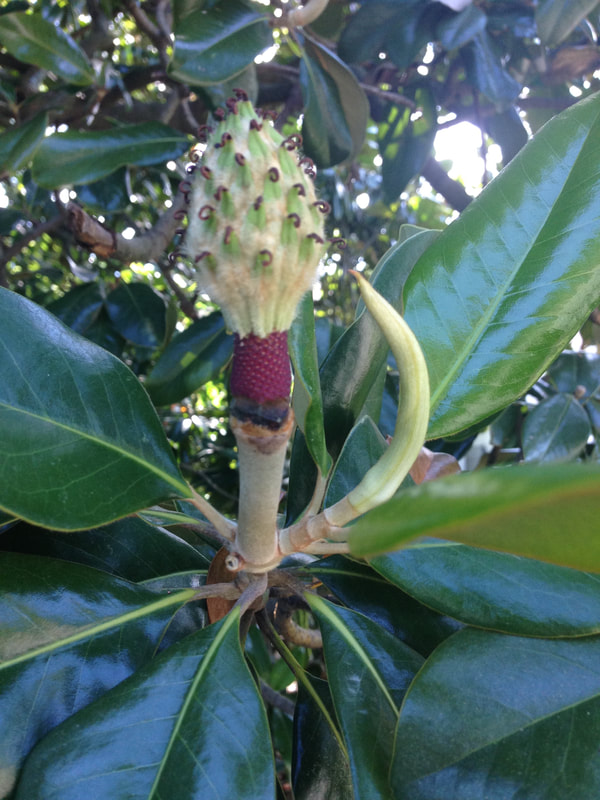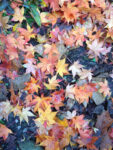Ancient Magnolia:
Peaceful Witness to Deeper Time
Come sit by me.
I have been here for such a long long time.
Lots of coming and going.
Still I watch.
Here is a spot for you, under my canopy.
No one can see you in here, but me, and no one is looking, not even me. There is a lot of space and even a low branch here;
I will hold you while you sit, and your feet can still reach the ground.
Just relax.
See what it is like to look out from here.
Come sit.
Magnolia, an ancient tree with large fragrant flowers, evolved before there were bees. (Bees evolved around 120 million years ago.) Let that sink in. Before there were bees, there were Magnolia trees.
Magnolias appear to be the first flowering plant. Before that, only conifers and cycads grew; and before that, only horsetails and ferns. Their flowers are pollinated by beetles, whom they attract with their strong fragrant scent. The flowers evolved to be somewhat tough to withstand the beetles exploration with their mandibles. Often appearing before the leaves on the deciduous versions, the flowers may be the first to bloom in spring in some varieties.
“Magnolias have witnessed the movement of continents, the proliferation of mammals, the emergence of hominids who use tools. They have endured the many climactic changes of the interglacial period. They hold the perspective of deep time. To contemplate how much they have seen is to remind oneself of the brief moment humans have walked this strange and wondrous planet.” (Janet Kent)
Magnolia’s historic distribution, prior to the last ice age, would have been across most of mainland Europe and the rest of the northern hemisphere, though since the last ice age its native range has predominantly been Asia and eastern America. Yes, one of those interesting plants that grows in both Asia and the Appalachians.
“The bark has been used in Traditional Chinese Medicine, and Japanese Traditional Medicine. It is very fragrant and contains large amount of two aromatic compounds called magnolol and honokiol. It was common to find it used to help support healthy digestion. Magnolia’s ‘stimulant’ and ‘tonic’ benefits were included in the U. S. Pharmacopoeia from 1820 -1894. Much of the research on this plant has centered around these two constituents. Magnolia bark and it’s various constituents have been shown to modulate cortisol production. The bark is commonly used in formulas to support healthy response to stress and calm occasional nervousness as well as to support sleep.” (Gaia Herbs website)
My grandparent’s, my mother’s parents Ruby and Lindsay, had a large magnolia in their front yard. Set back against the tall hedge that ran the length of their property, Magnolia fanned out wide, her low branches to the ground,her high branches facing the sky.Underneath that deep canopy was a playground of immense proportions to a child. While the grown ups sat on the porch on my Nana’s white wicker furniture, I spent hours under there, alone and with my cousins, playing all sorts of games and passing the long afternoons of a southern spring, summer and fall. And maybe even a warm winter day.
What I remember most, though, is how safe I felt there. So tucked in and protected. The deep green large leathery leaves made almost a wall to the rest of the yard, there was a small opening on the right side of the tree facing the driveway, and a low branch just perfect for sitting on, rocking a little, and resting and imagining. My endlessly busy mind often drew me to other adventures — up to the chock-full attic, down to the old garage barn (watch out for snakes!) or into the kitchen to see what my Nana was baking that day. Yet Magnolia was always there, with a wide apron and shelter. Kind of like my Nana (though she was anything but wide).
There is a volunteer Magnolia growing right next to the driveway in my little house in Winston-Salem. Over the past several years, the concrete driveway has started to buckle and lift up from the growing roots of the Magnolia. Last summer, concerned for my tenant living in the house, I thought perhaps I should remove the Magnolia and repave the driveway. SIGH. I even got a few bids. But I couldn’t do it. My heart kept saying: what do we need? more concrete for car parking or more trees? (And thankfully, for now, my tenant says she likes the tree and isn’t concerned about the driveway.) I have even envisioned shifting the driveway when I really have to tend it. I know, I know, I can hear the lawyers saying “what if your tenant ……?” And the neighbors with the very nice concrete and fancy yard saying “Isn’t she letting her place go? She doesn’t even live here. What a mess.” And yes, I am letting things be for now. It feels right in my heart.
When I really look, what I see is Magnolia showing me what is it like to keep growing through and maybe, just maybe, break up what seems like permanent constriction (and construction). Eventually. Just keep breathing. And offering presence.
Anyway, there’s a little view of my heart, and my heart’s longing to step into deeper time and observe through Magnolia’s lens, through the gentleness and the wisdom of eons of coming and going. Eons on the breath of Gaia.
The time we have been here as a species in very short. Each of our lifetimes pass in the blink of an eye. If this time of confinement is hard for you, for any reason, try spending time with these unfathomably old trees.
If you live in the Southeastern US, rejoice that you do not have to travel to see the Redwoods or the Gingko, more well known ancient trees: just walk outside and breathe in this ancient enduring presence. May we learn with Magnolia to breathe and endure through the changes, in peace.



